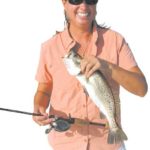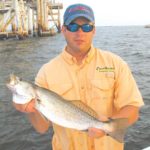
This perennial Black Bay hotspot is producing big trout and reds.
It started with a casual greeting just before daylight recently when I bumped into Capt. Charlie Thomason at the dock of Blackie Campo’s Marina in Shell Beach. We were both standing in the live bait line, and eager to get under way.
If you buy live bait, you know how antsy you get when your boat is in the water, the motor is running and the baitwell is pumping water just waiting for you to dump in the live shrimp or croakers so you can take off.
We were just making conversation and trying to be patient while they counted out our croakers, when Thomason casually mentioned that he was planning a special media day at his Hopedale camp. He’d invited all of his sponsors to come down and spend a few days fishing the Louisiana coast, and almost all of them had promised to come. Free food, drinks, hospitality and fishing are quite an enticement, and when he said I was also invited and he’d call me with the dates, I automatically responded with, “I’ll be there.”
And I was. For dinner, breakfast and fishing. Thomason’s camp and dock were busy with activity from the numerous sponsors and media representatives who came out for the event. Writers were there from several states, and Thomason assigned a writer to accompany each of the four boats that would be fishing that morning.
Capt. Shane Robin had Brandy Roughton, vice-president of Castaway Rods, and her friend, Cindy Gardner, aboard his boat, and Thomason decided to put me on board with them.
“Don’t worry,” Robin said to assuage my apprehension. “Those two are not girly-girls. They can fish. Yesterday they out-fished all the guys on board.”
“No problem on my end,” I said.
I figured any girl who was vice-president of a rod company ought to be able to cast and retrieve with the best of them.
The early morning skies were grey and ominous as Robin snaked the boat through bayous and ponds across Lake Robin and finally into Black Bay. A light-to-medium chop greeted us as we entered open water, and I wondered if we’d have to turn around and fish inside.
But Robin kept the bow of the 22-foot BlackJack pointed toward the Wreck, confident that big speckled trout awaited us and would reward our endurance with an aggressive bite.
“We’ve been fishing the islands and structures in Black Bay with good success,” he said. “The fish aren’t all stacked up in one spot like they were earlier in the summer, so you have to move around more to fill the box. But we pick up 15 or 20 in one spot, and maybe a dozen or so in another. We just keep moving until we either catch our limit or we use up the morning trying.”
Robin slowed the boat to almost idle, and motored to a corner of the big Wreck rig, one of the area’s perennial hotspots.
Rather than using a rig hook, he anchored upcurrent a pretty good distance from the rig, and let the boat fall back toward it. We would cast toward the rig, but I noticed we were still far enough away from the rig that you couldn’t reach it even with a long cast.
“The fish hang off the structure out here,” Robin said. “On weekends sometimes there are boats all around this rig, hooked on, fishing just below it or up against it. I come anchor way outside all of them, and start catching fish. Even anchored way back here, I have to sometimes cast away from the rig instead of toward it because the fish are still farther out.
“Normally, when I fish a big rig I anchor and cast toward it, and when I fish the small wellheads, I hook or tie on and fish out.”
The baitwell was loaded with live croakers, and since neither of the ladies had ever fished with live croakers before, Robin took a few minutes to instruct them on the art.
“We’ll use either a Carolina rig, or we’ll just hook them on a plain 3/8-ounce jighead and toss it out,” he said. “There’s a lot of stuff on the bottom to snag on, and retying a jig head is much faster than retying a Carolina rig. Sometimes it’ll make a difference. They might hit the Carolina rig and ignore the jighead, or vice-versa. But usually they’ll hit one just as readily as the other.
“And don’t be too quick to pull the trigger and set the hook when you get a hit. When you feel the line trembling and shaking, you’re going to be so tempted to jerk back on the rod and sink the hook into the fish’s jaw, but if you do you won’t catch anything.
“This is how the action will play out: When a big trout or red starts swimming near your bait, that croaker is going to get nervous and start tugging on your line. That’s the first thing you’ll feel — the short little bump-bumps on your line. That’s the croaker trying to escape. Don’t set the hook yet.
“Next, you’ll feel a bigger thump that you just know is definitely a strike. Your line will jerk and your rod tip will bounce, and your immediate instinct will be to set that hook. But don’t, not quite yet.
“For some reason, the trout will take a swipe at the croaker and knock it around a bit, without actually swallowing it. This is when you want to make sure your line is taught and the slack is out. The trout seem to want to stun the croaker first, and then they come back to swallow it. You’ll start to feel your line tightening up, and when you feel a definite pull on your line, then you set the hook.“Now if it’s a redfish that hits you, he’ll just swallow the whole croaker and run with it. Don’t worry, you’ll know when you have a red on the line.”
We tossed our baits on all sides of the boat hoping to locate the fish. Naturally, the technique is to find out where the fish are holding so everybody can cast toward them. It didn’t take long before we had a couple of hits off the back of the boat. I managed to quickly land a couple of nice trout in the 2- to 2½-pound range while the ladies were getting the hang of croaker fishing. But they caught on quickly, and soon both were reeling in some nice specks.
Then the big reds moved in and almost everyone had one on at the same time. My fish almost completely spooled me before it broke the line, but Brandy was spooled with Power-Pro and able to wear hers down. Robin netted the big bull, and while we didn’t weigh or measure it, we did photograph it and estimated it to be about 20 pounds. Minutes later, Cindy reeled in an almost identical fish.
These bulls were no doubt running in a pack and devouring everything in sight. We worried for a moment that the big reds may have spooked our trout, but a short time later, the specks turned on again, and we picked up where we left off.
“Sometimes, when those bull reds move in, the trout disappear. Fortunately we’re still on a good bite,” Robin said.
The ladies proved to be seasoned anglers, and didn’t hesitate to bait up their own hooks and retie their own lines. We started playing catch and release with the trout, and Robin decided to move us toward some islands where we could try some topwater baits.
“The islands and reefs are still pretty good right now,” he said. “But we’re getting into the time of year when the fish are going to start transitioning into the inside. There will still be fish outside, but you won’t have to run this far and burn the fuel to get to them.”
Robin only confirmed the recent conversation I’d had with Capt. John Serigne, who said the specks were already beginning to make an appearance in some of the transitioning hotspots such as Bay Jack, Pointe Fienne, Oak River and Little Crevasse.
“But as long as these big trout stay at the rigs and islands, I’m going to stay with them,” Robin said. “The Battledore Reef area has been producing some fish, and the various wellheads that dot Black Bay can be productive, but it’s hit and miss. You just have to keep moving until you find them.”
We all had a box of new MirrOlures to try. Our approach would be to drift along the back of an island and cast our topwater baits until we had some blow-ups, and then Robin would stick the Power-Pole down, and we’d try to stay with the action.
The water behind the island was not as choppy, and it lacked good clarity, but it wasn’t horrible. Everyone tied on a topwater MirrOlure in a variety of colors and sizes, and we worked every side of the boat. Again, our method was to see what bait and color provoked the most results, and we’d all switch to that. I tied on a chartreuse MirrOmullet, and had an instant response. The larger baits went virtually unnoticed, but the smaller lure was irresistible to the specks. After I landed several respectable fish, everyone else switched to the same bait.
After that action played out, we resumed drifting, and got into some choppy water where the smaller topwater bait was ignored by the trout, but the larger, nosier baits drew some good hits.
“The different baits really are designed for different conditions,” Robin said. “The smaller bait has fewer rattles, and doesn’t make much noise. It’s designed for fishing in relatively calm water where a big, noisy bait could spook the fish. But in a chop, you have to compete with the sound of the surf, and you need more noise and rattle to attract the fish, and that smaller bait is less likely to be seen.
“What I like to do is to troll or drift at a point in one of the bigger bays or along one of the islands out here. Stay far enough off the bank so that it takes a good, long cast to get your bait to the edge, and then walk it in. I like to work it a bit and then pause for a few seconds, and then walk it some more and pause again.
“By staggering your retrieve, you sometimes get more hits. Then at other times, they’ll hit it if you keep it moving and don’t stop or pause at all. But there are a few important points to keep in mind whenever you fish topwater baits: 1) Choose a bait appropriate for the conditions. Noisy bait in noisy conditions, smaller bait in calm water, etc. 2) Switch colors if you don’t get hits. Let everybody on board try a different color, and you can switch to what works best. 3) Let the fish hook themselves. Don’t be eager to jerk the rod when you get a topwater hit, or you’ll snatch it right out of their mouth and send all those hooks sailing back toward you and the crew on board. 4) If the fish blows up on your bait and misses it, don’t reel it in. Just start working it again. Usually they’ll come back for it and hit it again. 5) Work your bait all the way back to the boat. Sometimes the trout will follow your lure all the way from the bank and they’ll hit it just as you get to the boat.”
Capt. Shane Robin can be reached at (504) 512-3474.




